Complete Guide to Social Media Advertising 2024
Ad spending on social media reached over $181 billion in 2023. Number of people who use social media in 2023 is 4.89 billion. Considering the number of users, Ad Spending in social media advertising is projected to reach US $268.70 bn. (Source: Hootsuite)
Though businesses differ from one another but per day ad spends on social media advertisement is $200 to $350. Making investments for social media advertising depends on different aspects like growth, increase in target audience,and business expansion. Ad Spends on social media advertising is projected to reach US $1.15bn in 2023.
Let us dive deep to understand the dynamics of social media advertising.
What is Social Media Advertising?
Social media advertising is a kind of digital marketing that involves use of social platforms such as Twitter, Facebook, and Instagram. The intent is to reach a wider audience via paid ads.
- Social media ads are effective and make it quick for the audience to reach.
- Social media advertising enables the brands for hyper-personalized campaigns based on buyer’s persona, demographics, and behavior.
- Social Media advertising differs from other digital advertising in a way that it has several other platforms under it.
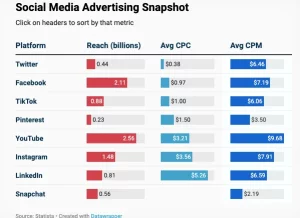
Social Media Stats
Here is the detailed insight of social media stats:
- Social media ads are the 4th biggest source of brand discovery and 2nd most popular channel for online research.
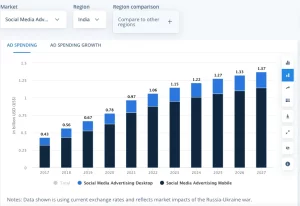
Source: www.statista.com
- Social media ads are the 2nd biggest market in digital ads after search advertising.
- Google controls about 28.6% of global digital spend.
- Social media advertising click through rate (CTR) worldwide is 1.21%.
- Social media advertising cost-per-mile (CPM) worldwide is 81.5USD.
- Expected ad revenue by Facebook is USD 71.32 billion in 2023.
- In 2023, the total ad revenue from Instagram is expected to rise by 19.4% to reach USD 39.7 billion.
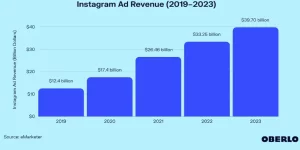
Common Types of Social Media Ads
These are the types of social media advertising examples that you would want for your brand marketing.
Image ads:
- These are ads that feature a single image or a carousel of images.
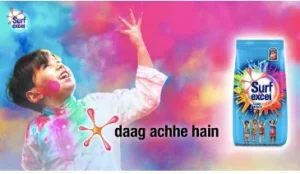
Source: www.google.com
- They can be used to promote products, services, or events.
- Image ads are commonly used on social media platforms such as Facebook, Instagram, and Twitter.
- Image ads can be static, animated, or interactive, including text, logos, and calls to action. They can also be targeted to specific audiences based on factors such as demographics, interests, and behaviors.
- Image ads can drive brand awareness, website traffic, or sales. They can also be used with other ad formats, such as video or carousel ads, for more effective campaigns.
- Advertisements are a source of information as well as entertainment. They are useful for advertisers as well as audiences. Ads allows brands to connect and hence they become the best medium of communicayion.
- There is no best time to launch image ads.
- In India, there can be specific events on which the ads can be launched. In common, image ads capture attention of the audience during the major national and regional festivals. A lot of campaigns help people associate with the image campaigns.
- Image ads yield high brand awareness when they are launched at the time of major sales events.
- Image ads can also spur the emotional connection with the brand during the time of any national sports or championship.
Video ads:
- These are ads that feature a video and can be used to demonstrate a product or service or to tell a story about a brand.

The chai slurping ad from Nazrana was an ideal way on how video marketing helped people connect with the message that brand wanted to convey easily.
- These ads can be played before, during, or after a video on a website or platform, such as YouTube, Facebook, or streaming services like Hulu and Netflix.
- Video ads can also be played as part of a more extensive video campaign on television or in movie theaters.
- The format of video ads can vary, but they are often short, engaging, and designed to grab the viewer’s attention quickly.
- The best time to play video ads can depend on several factors, including the target audience, the ad’s platform, and the overall advertising campaign strategy.
- For television advertising, prime-time slots (when most viewers are watching) are generally considered the best time to air ads.
- For online video platforms such as YouTube, the best time to play an ad can vary depending on the demographics of the audience and the type of content they are viewing. For example, if a brand targets working professionals, it may be best to show the ad during the workday when people are likely to take breaks and watch videos online.
- For video ads that run on social media platforms, the best time to show an ad can depend on the user’s habits and the content they engage with. For example, if a brand targets active users on social media during their commutes, it may be best to show the ad during peak commuter hours.
Story ads:
- These ads appear in the stories feature on social media platforms such as Instagram and Snapchat.
- They are typically full-screen, vertical videos or images that disappear after a few seconds. Story ads are a type of advertising format that uses a series of images or videos to tell a story or convey a message. They are typically used on social media platforms such as Instagram, Facebook, and Snapchat and are designed to be visually engaging and quickly capture the viewer’s attention.
- Story ads can take several forms, including:
- Carousel ads: These are ads that feature multiple images or videos that users can swipe through. They can be used to showcase different products or features of a service.
- Collection ads: A series of images or videos that link to a landing page or product page. These ads allow users to preview a selection of products and then click through to purchase them on the advertiser’s website.
- Canvas ads: A full-screen, interactive ad that allows users to engage with different elements on the screen, such as videos, images, and text.
- Story ads are designed to be more immersive than traditional ads and allow brands to create a more engaging and compelling experience for the viewer. They are particularly effective for promoting products and services that are visually appealing, such as fashion, beauty, and home decor.
- Story ads are also a great way to reach a younger audience, who are more likely to engage with visual content on their mobile devices, and to increase brand awareness, drive traffic to the website and increase conversion rate.
- One of the best examples of story ads is by Audible. This story ad by Audible conveys a direct message to the viewer. The copy of the brand says “Listen Only On Audible” which is the main catch to show the exclusivity of the product. The placement of the text and the design goes well to make an impression with the customers.
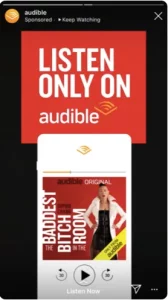
Source: www.google.com
- Make sure for story ads, you make the brand visible and make best use of the initial few seconds of the story. Position the text strategically and feature influencers in the stories.
- Stories ads are displayed as long as you run the campaign. You can place the story ad any time especially when you know that your target audience is active.
Slideshow ads:
- It features images that play automatically, with or without sound.

Source: www.google.com
- Slideshow ads are a video ad format that uses a series of still images to create a short video. They are designed to be lightweight and easy to develop, making them a cost-effective option for small businesses and marketers. Slideshow ads are typically used on social media platforms, such as Facebook, Instagram, and LinkedIn, and can also be used for display advertising on other websites.
- Some of the critical features of slideshow ads include the following:
- They are easy to create, as they can be made using a series of still images, background music, or voiceover.
- They are lightweight and load quickly, making them well-suited for mobile devices.
- They can be used to create a variety of ad formats, such as carousel ads, collection ads, and story ads.
- They can be used to promote a wide range of products and services, including e-commerce products, local businesses, and events.
- Slideshow ads are an excellent option for businesses that want to create engaging video content without the cost and complexity of traditional video production.
- They are also a good choice for small businesses or marketers with limited resources who need to make every dollar count.
Sponsored posts:
- Sponsored posts are advertisements on social media platforms where a company pays to promote its content to a larger audience.
- These posts may appear in a user’s feed and are typically labeled as “sponsored” or “promoted.”
- They are a form of influencer marketing, allowing companies to reach a target audience through social media influencers or accounts with a large following.
- The best time for sponsored posts on Instagram is between 11am to 1pm.
- Sponsored content can be articles, infographics, and social media content.
- Sponsored content is an ad post that does not look like an ad.
- This is an example of a sponsored ad where Spotify sponsored the Buzzfeed article on “15 bands that probably wouldn’t exist without Led Zeppelin”.
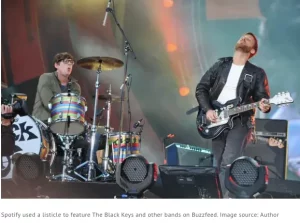
- In another example, YouTube sponsored “Someecards” to promote their content creators. They created a basic e-card to promote Lilly Singh and Tyler Oakley. This sponsored content was shared by 38,000 users.
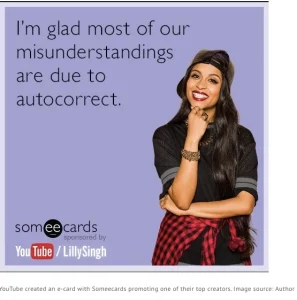
Influencer Marketing:
- Influencer marketing is a form of marketing in which brands partner with individuals with a large following on social media platforms, such as Instagram, TikTok, YouTube, and Twitter, to promote their products or services.
- These individuals, known as influencers, use their platforms and personal brand to reach a large audience and create a sense of trust and credibility for the products or services they promote.
- Influencer marketing can take many forms, including sponsored posts, product mentions, and affiliate marketing.
- The goal of influencer marketing is to drive engagement and sales by leveraging the trust and credibility that influencers have built with their followers.
- Best time to use influencer marketing is the holiday time or year-end festive season, usually when the brands receive the highest sales.
- An example of influencer marketing was that of Dunkin’s Donut. The brand had a huge following on TikTok. The brand usually shared how the world-famous donuts were made. To increase its customer reach, Dunkin did a long-term sponsorship with Charli D’ Amelio, who has more than 144 million followers on the platform. Charli was also allowed to make her own TikTok content for the campaign in addition to posing with Dunkin’ items as part of the agreement. The brand soon launched a drink with the name “The Charli”.
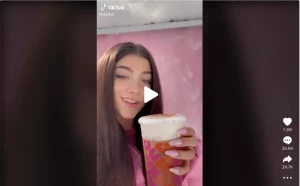
Live video:
- These ads feature live video content, which can showcase events, products or services in real-time.
- Live video advertising is a form of advertising that utilizes live-streaming technology to reach a target audience in real-time. Live video content is often used to promote products or services, provide behind-the-scenes access, or offer exclusive content. Live videos can be streamed on various social media platforms such as YouTube, Facebook, Instagram, Twitter, and TikTok.
- Live video advertising can effectively increase brand awareness, engagement, and conversions, as it allows businesses to connect with their audience in a more personal and authentic way.
- Live videos are unedited and unscripted, creating a sense of authenticity and immediacy that can appeal to audiences. These videos also have a sense of exclusivity, as they are only available to watch in real time, which can increase the sense of urgency for viewers to tune in.
- Live video advertising can also be used for events, webinars, product demos, Q&A sessions, etc. Businesses can use live video to give their audience a behind-the-scenes look at their operations or to provide expert advice and insights.
- Live video can also be used for e-commerce, such as product launches, flash sales and live Q&A sessions with the company’s representatives.
Read: How to advertise on Instagram?
Objectives of Social Media Ads
The objectives of social media ads can vary depending on the business or organization running the campaign. However, some common objectives include:
- Increasing brand awareness: Social media ads can be used to increase visibility and familiarity with a brand or product.
- Driving website traffic: Social media ads can be used to drive clicks to a website, where users can learn more about a product or service.
- Generating leads: Social media ads can be used to collect contact information from users, such as email addresses, to build a list of potential customers.
- Selling products: Social media ads can be used to directly promote and sell products, using features such as shoppable posts or sponsored product listings.
- Boosting engagement: Social media ads can be used to increase engagement with a brand or product, such as likes, shares, and comments on social media posts.
- Target specific audience: Social media platforms allow to target specific demographics, interests, behavior and location, which allows businesses to reach their ideal customer.
Benefits of Social Media Advertising
Marketing professionals can use social media advertising to increase audience engagement, brand awareness, and conversion rates. The exact audience targeting offered by social media advertising is one of its most significant benefits. Five additional advantages of social media advertising are as follows:
More Control Over Your Ads
Traditional advertising has the drawback that you have no control over the results once your ad is live. However, you have fine-grained control over the campaign using social media advertising. The budget, targeting, creatives, and delivery can change as you go. This gives advertisers a greater sense of control and offers several options for real-time campaign optimization.
Large Reach:
Social media platforms have billions of active users, which provides a large audience for businesses to target with their advertising.
Targeted Advertising:
Social media platforms offer a variety of targeting options, such as demographics, interests, and behaviors, which allows businesses to reach the most relevant audience for their products or services.
Cost-effective:
Social media advertising is often less expensive than traditional forms of advertising, such as television or print.
Measurable Results:
Social media platforms provide detailed analytics and metrics, which allows businesses to track the success of their advertising campaigns and make data-driven decisions.
Increased Engagement:
Social media platforms provide businesses with the opportunity to interact and engage with their target audience, which can lead to increased brand loyalty and advocacy.
Multi-Purpose:
Social media platforms are not only used for advertising, but also for building relationships, promoting content, and customer service.
Increasing Popularity:
Social media usage is increasing rapidly, especially with the younger demographic, so it provides an opportunity for businesses to reach a wider audience.
Popular Social Media Advertising Platforms
These are the popular platforms:
Facebook:
-
- According to data from Statista, as of January 2021, Facebook had over 2.8 billion monthly active users worldwide.
- Additionally, the platform has a large and diverse user base, with users of all ages and from all over the world.
- Facebook also offers a range of advertising options, including image, video, and carousel ads, as well as sponsored posts and stories.
- Because of its large user base and targeting options, Facebook can be an effective platform for businesses of all sizes to advertise.
Instagram:
-
- As of January 2021, Instagram had over 1 billion monthly active users worldwide, according to data from Statista.
- Instagram is particularly popular among younger users, with a large percentage of its user base being under 35.
- The platform offers a range of advertising options, including image and video ads, carousel ads, and sponsored posts and stories.
- Instagram’s focus on visual content and its large, engaged user base makes it a popular platform for businesses in fashion, beauty, and travel to advertise.
Twitter:
-
- Twitter is a powerful marketing tool for businesses and organizations.
- According to a study by Hubspot, tweets with images receive 18% more clicks, 89% more favorites, and 150% more retweets than tweets without images.
- Additionally, tweets with hashtags receive twice as much engagement as tweets without hashtags.
- Twitter also offers paid advertising options, such as promoted tweets and promoted accounts, which can help businesses reach a larger audience and drive more website traffic.
- Twitter’s ad platform allows for targeting specific demographics, interests and behaviors. In 2020, Twitter’s ad revenue was $1.47 billion.
LinkedIn:
-
- LinkedIn is a professional networking platform that can be a valuable tool for marketing businesses and organizations.
- According to a study by Hootsuite, LinkedIn is the most effective social media platform for B2B lead generation.
- A survey by Sprout Social found that LinkedIn is the most effective social media platform for content marketing, with 61% of B2B marketers rating it as the most effective platform.
- A study by Hubspot found that LinkedIn is 277% more effective at generating leads than Facebook and Twitter.
- LinkedIn’s ad platform allows for targeting specific demographics, job titles, company sizes, and industries. As of 2020, LinkedIn’s ad revenue was $1.78 billion.
- In 2020, LinkedIn had over 722 million users globally, with more than 70% outside the US.
TikTok
-
- TikTok is a social media platform growing in popularity, particularly among younger users. As of 2020, TikTok had over 2 billion downloads globally.
- In 2020, TikTok had over 689 million monthly active users in China and 689 million active users outside China.
- According to a survey by Hootsuite, 37% of US adults between the ages of 18 and 24 use TikTok.
- TikTok is particularly popular among younger users, with 70% of US TikTok users being under the age of 30, according to a survey by the Pew Research Center.
- TikTok’s ad platform allows for targeting specific demographics, interests, and behaviors.
- TikTok’s ad revenue was $176 million in 2020, projected to reach $1.1 billion in 2021.
Snapchat
-
- Snapchat is a popular social media platform worldwide, but its usage in India is relatively low compared to other platforms such as YouTube, Facebook and Instagram. As of 2021, Snapchat has around 24 million monthly active users in India.
- A study by eMarketer found that Snapchat reaches only 6.3% of India’s internet users.
- A survey by the Internet and Mobile Association of India (IAMAI) found that Snapchat is not among the most popular social media platforms among urban internet users in India.
- A Boston Consulting Group (BCG) and Google study found that Snapchat has a small market share of 2% in India for online video advertising.
- Most of the users of Snapchat in India are from Tier 1 and 2 cities and the age group of 18-24 years old.
Youtube:
-
- YouTube is a popular platform in India and can be a powerful marketing tool for businesses and organizations in the country. As of 2021, YouTube has over 400 million monthly active users in India.
- According to a report by eMarketer, YouTube reaches 88.8% of India’s internet users.
- A study by Google and KPMG found that YouTube is the top choice for online video consumption in India, with 96% of internet users watching videos on the platform.
- A survey by the Internet and Mobile Association of India (IAMAI) found that YouTube is the most popular social media platform among urban internet users in India, with 89% of respondents using it.
- A Boston Consulting Group (BCG) and Google study found that YouTube is the most popular platform for online video advertising in India, with a market share of 63%.
- The average watch time for YouTube videos in India is around 40 minutes per session.
Pinterest:
-
- Pinterest is a social media platform that allows users to share and discover new interests by creating virtual boards and pinning images, videos, and other content.
- As of 2021, Pinterest has around 6 million monthly active users in India.
- A study by eMarketer found that Pinterest reaches only 2.1% of India’s internet users.
- A survey by the Internet and Mobile Association of India (IAMAI) found that Pinterest is only one of the most popular social media platforms among urban internet users in India.
- BCG and Google study found that Pinterest has a small market share of 1% in India for online video advertising.
- The majority of the users of Pinterest in India are from Tier 1 and 2 cities, and the age group of 25-34 years old.
How to do Advertisement on Social Media?
This is how you advertise on social media:
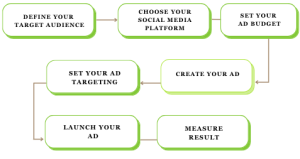
Define your target audience:
Before creating an ad, defining your target audience is important. Consider age, gender, location, interests, and behaviors to ensure your ad reaches the right people.
Different platforms have different audiences and ad formats. Choose the platform that best suits your business and goals. For example, Facebook is great for B2C businesses, while LinkedIn is more suitable for B2B.
Set your ad budget:
Determine how much you will spend on your ad campaign. Most social media platforms have various options, from daily to total campaign budgets.
Create your ad:
Depending on the platform, you can choose from various ad formats, such as image ads, video ads, carousel ads, or story ads. Remember your target audience when designing your ad, and include a strong call-to-action to encourage users to take action.
Set your ad targeting:
Use the targeting options the social media platform provides to ensure that your ad reaches the right audience. You can target users based on demographics, interests, and behaviors and even retarget users who have interacted with your brand.
Launch your ad:
Once you’ve created it and set your targeting options, it’s time to launch it. Monitor your ad’s performance regularly and adjust as needed to optimize for better results.
Measure your results:
Use the analytics provided by the social media platform to measure the performance of your ad. Track metrics such as impressions, clicks, conversions, and ROI to evaluate the effectiveness of your ad campaign.
How Much Does Social Media Advertising Cost?
Here is a quick glimpse of how much the ads cost on social media platforms:
| Social Media Platform | Ad Costs in India |
| Facebook Ads | The average cost click for Facebook advertising is around ₹0.51 to ₹2.26 |
| Instagram Ads | Instagram CPM (cost per 1000 impressions), ₹8 to Rs. 12 ; InstagramCPC (cost per link click), ₹0.48 to Rs. 2.8. |
| Twitter Ads | Twitter promoted ads average about $0.25 to $2 per action |
| LinkedIn Ads | Minimum budget for LinkedIn is $12. |
| Snapchat Ads | The cost per thousand impressions (CPM) can range from around $1 to $5 |
| Youtube Ads | Lower than other countries. |
| Lower than other countries. | |
| TikTok | Lower than other countries. |
Read: 6 Types of Social Media Ads.
How to Choose the Right Social Media Platform for Advertising?
Choosing the right social media platform for advertising can be an essential factor in the success of your ad campaign.
Here are a few key factors to consider when making your decision:
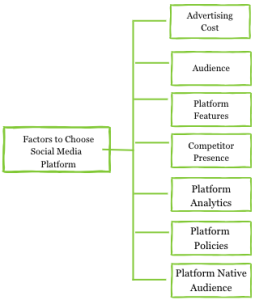
- Audience: The most crucial factor to consider is the audience you want to reach. Different social media platforms have different user demographics, so it’s essential to choose a platform that is popular among your target audience.
- The platform features: Each platform has unique features, such as ad formats and targeting options, so it’s essential to choose a platform that offers the most relevant features to your business goals.
- Competitor presence: Look at where your competitors are advertising and which platforms they are using. This can help you identify which platforms are most popular among businesses in your industry.
- Advertising cost: Some platforms can be more expensive than others, so it’s essential to consider your budget when deciding.
- Platform’s analytics: It’s essential to have access to detailed analytics to track the performance of your ad campaigns and make adjustments as needed.
- Platform’s policies: Some platforms have stricter ad policies than others, so it’s essential to be aware of any restrictions or guidelines that may apply to your ad campaign.
- Platform’s native audience: Some platforms have a native audience that is more likely to engage with certain types of content. For example, Instagram is great for visual content and TikTok for short videos.
Steps to Optimise Your Social Media Ads
These are the tips to optimize social media ads:
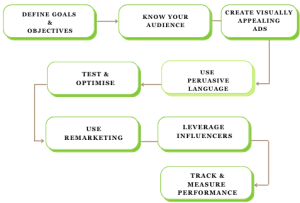
Define clear goals and objectives:
Before launching a social media advertising campaign, it’s essential to define them. This will help you measure the success of your campaign and make data-driven decisions.
Know your audience:
Understand your target audience, their demographics, interests, and behaviors. Use this information to create highly targeted campaigns that resonate with your audience.
Create visually appealing ads:
Use high-quality images and videos to grab your target audience’s attention.
Use persuasive language and calls to action:
This technique in your ad copy to encourage users to take the desired action, whether visiting your website or making a purchase.
Test and optimize:
Use A/B testing to compare different versions of your ads and determine which one performs best. Continuously optimize your ads based on the results.
Use remarketing:
Remarketing allows you to target users who have already interacted with your brand, increasing conversion chances.
Leverage influencers:
Influencer marketing can be a powerful tool for promoting your brand on social media. Partner with influencers in your industry to reach a larger audience and increase brand awareness.
Track and measure your performance:
Use the analytics provided by social media platforms to track the performance of your ads. Use the data to make informed decisions and optimise your campaigns.
Read: Guide to Advertising on Amazon
How to Measure Social Media Marketing Success?
Measuring the success of a social media marketing campaign can be done by tracking various metrics, such as:
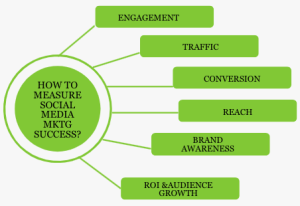
- Engagement: This includes metrics like likes, comments, shares, and mentions. It measures the level of social media engagement and interaction with your brand.
- Traffic: Track the number of clicks on your website or landing page from your social media campaigns. This will show you how well your social media efforts drive traffic to your website.
- Conversion: Track the number of conversions that come from your social media campaigns, such as sales or sign-ups. This will give you an idea of how well your social media efforts drive business results.
- Reach: Track the number of people who have seen your social media posts; this will give you an idea of how far your message is reaching.
- Brand awareness: Track the number of people aware of your brand and its offerings; this can be done by conducting surveys and interviews.
- ROI: Track the return on investment (ROI) of your social media campaigns; this can be done by dividing the revenue generated by the cost of the campaign.
- Audience growth: Track the growth of your social media audience; this can be done by monitoring the number of followers, friends, and connections.
Conclusion
Social media advertising is an essential aspect of any digital marketing strategy. With the right targeting, creativity, and messaging, businesses can reach their target audience, increase brand awareness, drive conversions, and boost revenue. Following the steps outlined in this guide, businesses can create effective social media ads that deliver results.
It is important to remember that social media advertising is an ever-evolving field. Therefore, businesses must stay up-to-date with the latest trends and best practices to stay ahead of the competition. By continuously optimizing their ad campaigns and experimenting with new strategies, businesses can maximize their ROI and achieve their marketing goals on social media.
Connect with us for social media advertising.
FAQ’s-
Why is social media advertising important?
Social media advertising is essential to increase the reach of the brand to the target audience. It allows the companies to capture the target audience based on the demographics, behavior, interest, and locations. The medium of marketing provides detailed analytics to track the performance of the campaigns and make improvements accordingly. Social media marketing creates a brand image and reputation with their target audience to increase brand loyalty.
Is social media advertising cost effective?
Yes, social media advertising is cost-effective as it allows the brands to reach their target audience at a relatively low cost. It makes the marketing cost-effective as the strategy makes brands pay only when someone clicks on their ads. Strategically, it helps to save money.
Advertisers can set a budget for their campaigns and adjust them when needed. Targeting specific demographics, interests, behaviors, and locations allows businesses to reach their desired audience more efficiently, reducing the cost per impression. Some platforms allow for automated bids for their campaigns.
What are the types of social media advertising?
These are are the types of social media advertising:
- Paid social media posts
- Display ads
- Video ads
- Influencer marketing
- Sponsored Content
- Lead generation ads
- Carousel ads
How do you advertise on social media?
For advertising on social media, this is what you will have to follow:
- Begin with choosing a platform which is popular amongst the target audience and where your competitors are also there.
- Set up an account on the chosen platform, if you don’t already have one.
- Decide what you want to achieve with your ad campaign, such as increasing brand awareness, driving website traffic.
- Use the platform’s ad creation tools to design your ad, including selecting the format, targeting options, and budget. Make sure to use high-quality images and persuasive copy.
- Use the platform’s ad creation tools to design your ad, including selecting the format, targeting options, and budget. Make sure to use high-quality images and persuasive copy.
- Select the demographics, interests, behaviors and location of the audience you want to reach.
- Decide how much budget you have to spend on your ad campaign.
- Submit your ad for review and launch your campaign.
- Track the performance of your ad campaign, using the platform’s analytics tools, and make adjustments as needed.



